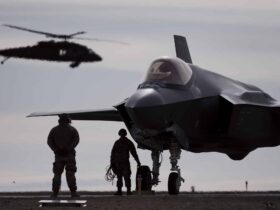The arrests of Ovidio Guzmán López, eldest son of Joaquín “El Chapo” Guzmán Loera, in 2019 and again in January 2023 bring the topic of designating Mexican Drug Trafficking Organizations (DTOs) as foreign terrorist organizations (FTOs). In 2019, Mexican security forces detained but quickly released Guzmán López after numerous Sinaloa Cartel gunmen engaged them for several hours in intense firefights across the city of Culiacán. Again in 2023, Sinaloa Cartel fighters wreaked havoc on Culiacán following the subsequent arrest of Guzmán López, including firing on commercial aircraft with heavy weapon systems. These responses are not unlike what the Taliban and similar insurgent groups have done after the capture of high-value members by state security services.
Given this level of open warfare and employment of terrorist tactics by the cartels, is it not time to consider seriously designating what amounts to criminal insurgencies as FTOs? This question was the foundation of my original dissertation (I had to abandon it due to academic “researchability”) and a significant policy interest of former President Trump. However, this argument has reentered political discussions after these fierce battles between the cartel forces and Mexican security services following Guzmán López’s rearrest.
The most prominent argument against this policy is that the cartels’ “ideology” is financial gain, not political change. Nevertheless, one could argue that “plata o plomo” (silver or lead) threats to influence politicians and citizenry is no different than those used by other recognized terrorist organizations. A new term that may help shift that thinking is a criminal insurgency – an insurrection in the furtherance of an illicit business.
The following is an excerpt from a threat assessment and policy analysis paper I wrote two years ago supporting this new designation of Mexican DTOs.
Drug trafficking organizations (DTOs) have presented an exponentially increasing global security threat since the former U.S. President Richard Nixon’s 1971 declaration of the “War on Drugs.” Drug trafficking had already been incorporated into the illicit business enterprises of organized crime for several decades but was not their primary focus. The Colombian Medellin Cartel was one of the first DTOs labeled as narco-terrorists following a bombing campaign that included the 1989 downing of a commercial airliner. The narco-terrorist moniker fell out of common usage for several years following Pablo Escobar’s death and the Medellin Cartel’s dismantling. Narco-Terrorism became more commonly associated with guerrillas and revolutionaries such as Fuerzas Armadas Revolucionarias de Colombia (FARC; the Revolutionary Armed Forces of Colombia), who funded their insurgency operations through trafficking narcotics (Williams Felbab-Brown 2012).
Modern Mexican DTOs’ use of an exponentially escalating level of violence has once again given cause within global security circles to characterize the cartels as narco-terrorists. The DTOs’ terroristic tactics, techniques, and procedures, such as beheadings, torture, family annihilation, and public assassinations, echo those used by Da’esh (ISIS or Islamic State) and Al Qa’ida (Bunker, Campell, and Bunker 2010). The crime-terror nexus between the cartels and foreign terrorist organizations such as Hezbollah and Al Shabaab has also justified designating these DTOs as narco-terrorists (U.S. House of Representatives 2011). However, the partnership between Mexican DTOs and foreign terrorist organizations is still relatively limited and narrowly focused. It is primarily considered an emerging threat and not an immediate concern to the global security community. There is undoubtedly cause for concern due to the uncovering of a plot by the Iranian Republican Guard Corps (IRGC) Quds Force to kill the Saudi Arabian ambassador to the U.S. using Los Zetas sicarios (assassins) in 2011 (McCaul 2015; Schofield 2015).
The Los Zetas Cartel had earned the reputation of being one of the most brutal and violent Mexican DTOs and set the example for the narco-terrorism that would follow. The methods its sicarios and enforcers used to protect or expand its criminal enterprise mirrors those used by Da’esh when seizing power in Iraq and Syria or the Taliban during its twenty-year insurgency. Arturo Guzmán Decenas, a defector from the Mexican Army’s Grupo Aeromóvil de Fuerzas Especiales (GAFES; Airborne Special Forces Group), founded the Los Zetas in 1997. Decenas served on protective security details for the Gulf Cartel’s boss, Osiel Cardenas Guillen. He later recruited thirty other rogue commandos from his former unit, and the elite group operated as bodyguards, enforcers, and assassins at Guillen’s direction for the Gulf Cartel.
The Zetas’ extensive military training and logistical comprehension allowed them to break from the Gulf Cartel in 2004 and gave them a distinct advantage over their rival DTOs. The two DTOs maintained relative peace for several years but expectedly came into direct conflict vying over territory and influence, resulting in brutal violence (Campbell, 2010; Logan, 2011; Logan, 2017). However, in recent years, the Zetas have been surpassed by the Sinaloa Cartel in strength, and the Los Caballeros Templarios (Knights Templar) narcocultos and Cártel Jalisco Nueva Generación (CJNG; Jalisco New Generation Cartel) in violence and brutality.
Analysts must examine nine base elements to best profile the Mexican DTOs’ global security threat. These are leadership and organizational structure, the number of personnel and key leaders, the scale of weapons access, finances and sources of funding, controlled territories, and safe havens, intelligence capabilities, communication security and techniques, methods and ease of movement, and agenda (Larson et al. 2008). Understanding these nine components can begin to identify the Mexican DTOs’ narco-terrorist ideology as essentially a criminal insurgency.
These organizations influence local, state, and federal politics and security to their benefit, and they use violence and acts of terror to enforce or propagate their agendas (Teiner 2020). Virtually no area in Mexico lies unclaimed by one of the various DTOs. This regional control gives each significant freedom of movement, numerous departure points, and large population pools to hide among and exploit. Border and coastal regions are the most highly prized for their utilization in trafficking, and many territorial conflicts have erupted over control of these areas (Beittel 2020).
Following the Zetas’ and Gulf Cartel’s example, many Mexican DTOs transitioned from simply bribing or coercing military, intelligence, and police personnel to perform services to recruiting them full-time. This endeavor afforded the DTOs pervasive and sophisticated intelligence and communications networks and capabilities that rivaled state counternarcotics units. The DTOs did not resign themselves solely to Mexican security service personnel and recruited renegade Guatemalan Special Forces, known as Kaibiles, for assassinations and espionage. Mexican DTOs have even hired former U.S. military and law enforcement personnel to serve as hitmen, bodyguards, and enforcers.
Additionally, DTOs regularly utilize prison and criminal street gangs like La Eme and the El Salvadoran Mara Salvatrucha (MS-13) for minor illegal activities and other trivial illicit operations (Valencia, 2014). The influx of trained security and defense force personnel has also increased the availability of military weapons and equipment and the technical and tactical capability to use them effectively against rival cartels and state counternarcotics forces (Campbell 2010). The Sinaloa Cartel demonstrated this military proficiency and ability when the DTO’s gunmen forced the release of one of Joaquin “El Chapo” Guzman’s sons, Ovidio, in Culican during a prolonged firefight and standoff in late 2019 (Beittel 2020).
As was briefly discussed above, Mexican DTOs have been increasingly cultivating relationships with recognized terrorist organizations like Al-Shabaab from Somalia and the Shi’ite militia, Hezbollah, out of Lebanon, as well as the recently designated IRGC Quds Force (McCaul 2012; Schofield 2015). The criminal collaboration has generally consisted of money laundering, arms smuggling, and drug trafficking; there have been, however, case examples of DTOs providing training for extremist operatives to successfully cross international borders and conceal their country of origin (Rollins, Wyler, and Rosen 2010). Although this is a fledgling partnership and not currently normative, it does set a dangerous precedent and the potential for escalating transnational violence and violent extremist attacks.
The threat assessment has established that Mexican DTOs fit within the basic narco-terrorism parameters through their methodology and tactics comparable to foreign terrorist organizations such as Da’esh or Al Qa’ida. Furthermore, the Mexican DTOs exploit economically depressed areas and populations with a proclivity for corruption within government agencies and the security services, increasing instability and insecurity. In addition, their engagement in the international drug trade and extreme violence established them as a global security threat and earned the designation of foreign terrorist organizations.
References
Beittel, June. 2020. Mexico: Organized Crime and Drug Trafficking Organizations. Washington, D.C.: Congressional Research Service.
Bunker, Pamela L., Lisa J. Campbell, and Robert J. Bunker. 2010. “Torture, Beheadings, and Narcocultos.” Small Wars and Insurgencies 21 (1): 145-178. doi:10.4324/9781315875477-9.
Campbell, Howard, and Tobin Hansen. 2014. “Is Narco-Violence in Mexico Terrorism?” Bulletin of Latin American Research 33 (2): 158–73. doi:10.1111/blar.12145
Campbell, Lisa J. 2010. “Los Zetas: operational assessment.” Small Wars & Insurgencies 21 (1): 55-80. doi:10.1080/09592310903561429.
Grayson, George. 2007. Mexico and Drug Cartels. Philadelphia, PA: Foreign Policy Research Institute. https://www.fpri.org/enotes/200708.grayson.mexicodrugcartels.html.
Haupt, David. 2009. Narco-Terrorism: An Increasing Threat to U.S. National Security. Norfolk, VA: Joint Forces Staff College, Joint Advanced Warfighting School.
Joint Chiefs of Staff. 2014. “J.P. 3-26: Counterterrorism.” Washington, D.C.: Joint Chiefs of Staff. http://www.dtic.mil/doctrine/new_pubs/jp3_26.pdf.
Knowles, Gordon. 2008. “Organized Crime and Narco-Terrorism in Northern Mexico.” Military Review, January/February: 73-84.
Larson, Eric V., Derek Eaton, Brian Nichiporuk, and Thomas S. Szayna. 2008. Assessing Irregular Warfare. Santa Monica, CA: RAND Corporation. https://www.rand.org/content/dam/rand/pubs/monographs/2008/RAND_MG668.pdf.
Logan, Samuel. 2011. “Preface: Los Zetas and a new barbarism.” Small Wars & Insurgencies 22 (5): 718-727. doi:10.1080/09592318.2011.620809.
Logan, Samuel. 2017. “A Profile of Los Zetas: Mexico’s Second Most Powerful Drug Cartel.” Combating Terrorism Center at West Point.
McCaul, Michael. 2012. A Line in the Sand: Countering Crime, Violence, and Terror at the Southwest Border. Washington, D.C.: United States House Committee on Homeland Security Subcommittee on Oversight, Investigations, and Management. https://homeland.house.gov/files/11-15-12-Line-in-the-Sand.pdf.
Miller, Abraham H., and Nicholas A. Damask. 1996. “The Dual Myths of ‘Narco‐Terrorism’: How Myths Drive Policy.” Terrorism and Political Violence 8 (1): 114-131. doi:10.1080/09546559608427336.
Robles, Gustavo, Gabriela Calderón, and Beatriz Magaloni. 2013. The Economic Consequences of Drug Trafficking Violence in Mexico. Stanford, CA: Stanford University.
Rollins, John, and Liana Sun Wyler. 2013. Terrorism and Transnational Crime: Foreign Policy Issues for Congress. Washington, D.C.: Congressional Research Service.
Rollins, John, Liana Sun Wyler, and Seth Rosen. 2010. International Terrorism and Transnational Crime: Security Threats, U.S. Policy, and Considerations for Congress. Washington, D.C.: Congressional Research Service.
Schofield, Mike. 2015. “The Crime-Terror Nexus and the Threat to U.S. Homeland Security.” Master’s thesis, Naval Postgraduate School. http://www.dtic.mil/dtic/tr/fulltext/u2/1009229.pdf.
Sullivan, Mark, and June Beittel. 2014. Latin America: Terrorism Issues. Washington, D.C.: Congressional Research Service.
Teiner, David. 2020. “Cartel-Related Violence in Mexico as Narco-Terrorism or Criminal Insurgency: A Literature Review.” Perspectives on Terrorism 14 (4): 83-98.
Trejo, Guillermo, and Sandra Ley. 2018. “Why Did Drug Cartels Go to War in Mexico? Subnational Party Alternation, the Breakdown of Criminal Protection, and the Onset of Large-Scale Violence.” Comparative Political Studies 51 (7): 900–937.
Turbiville, Graham H. 2010. “Firefights, Raids, and Assassinations: Tactical Forms of Cartel Violence and Their Underpinnings.” Small Wars & Insurgencies 21 (1): 123-144. doi:10.1080/09592310903561577.
United Nations Office on Drugs and Crime. 2010. The Globalization of Crime: A Transnational Organized Crime Threat Assessment. Vienna, AT: United Nations Office on Drugs and Crime. http://www.unodc.org/documents/data-and-analysis/tocta/TOCTA_Report_2010_low_res.pdf.
U.S. House of Representatives. 2012. A Call to Action: Narco-terrorism’s Threat to the Southern U.S. Border: Hearing Before the Subcommittee on Oversight, Investigations, and Management of the Committee on Homeland Security, House of Representatives, One Hundred Twelfth Congress, First Session, October 14, 2011. Washington, D.C.
Valencia, Daniel. 2014. “The Evolving Dynamics of Terrorism: The Terrorist – Criminal Nexus of Hezbollah and The Los Zetas Drug Cartel.” Master’s thesis, University of Texas-El Paso.
Williams, Phil, and Vanda Felbab-Brown. 2012. Drug Trafficking, Violence, and Instability. Carlisle, PA: Strategic Studies Institute, U.S. Army War College.
___________________________
This first appeared in The Havok Journal on February 15, 2023.
Ben Varlese is a former U.S. Army Mountain Infantry Platoon Sergeant and served in domestic and overseas roles from 2001-2018, including, from 2003-2005, as a sniper section leader. Besides his military service, Ben worked on the U.S. Ambassador to Iraq’s protective security detail in various roles, and since 2018, he has also provided security consulting services for public and private sectors, including tactical training, physical and information security, executive protection, protective intelligence, risk management, insider threat mitigation, and anti-terrorism. He earned a B.A. and an M.A. in Intelligence Studies from American Military University, a graduate certificate in Cyber Security from Colorado State University and is currently in his second year of AMU’s Doctorate of Global Security program.
As the Voice of the Veteran Community, The Havok Journal seeks to publish a variety of perspectives on a number of sensitive subjects. Unless specifically noted otherwise, nothing we publish is an official point of view of The Havok Journal or any part of the U.S. government.
Buy Me A Coffee
The Havok Journal seeks to serve as a voice of the Veteran and First Responder communities through a focus on current affairs and articles of interest to the public in general, and the veteran community in particular. We strive to offer timely, current, and informative content, with the occasional piece focused on entertainment. We are continually expanding and striving to improve the readers’ experience.
© 2024 The Havok Journal
The Havok Journal welcomes re-posting of our original content as long as it is done in compliance with our Terms of Use.










Leave a Reply